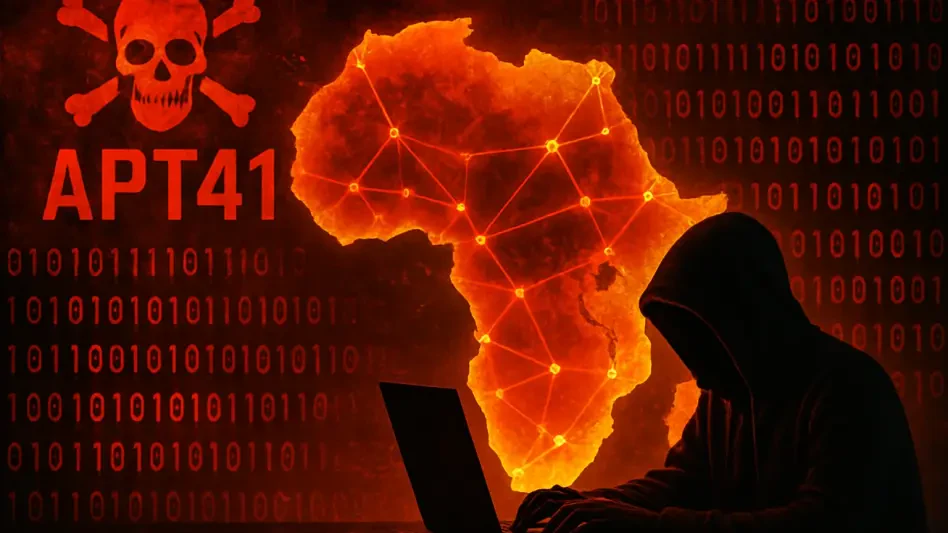The digital landscape in Africa has recently become a battleground for cyber warfare, marked by a significant cyberattack orchestrated by APT41, a notoriously adept Chinese state-backed cyber threat group. Known also as Wicked Panda, APT41 is recognized for its dual-purpose missions serving both espionage and financial cybercrime. Traditionally, this group targeted U.S. enterprises and other entities that align with Beijing’s interests, but this new foray into African cyberspace signifies a potential shift in strategic focus, indicating Africa as an emerging target of international cyber threats.
APT41’s Sophisticated Tactics
Customized and Strategic Methods
APT41’s sophistication is displayed in its deployment of intricate and customized cyber-attacks, enabling it to breach its targets with precision and stealth. The group’s latest incursion in Africa was brought to light by Kaspersky researchers who discovered their significant infiltration tactics. APT41 managed to use tailored malware that contained specific information about the internal workings of an African IT service provider. They capitalized on familiarity with the organization’s infrastructure to execute an attack from within, employing a SharePoint server in the victim’s network as a C2 server. This not only showcased a high level of customization but also made detection exceedingly difficult.
By employing its established tactics, techniques, and procedures (TTPs), APT41 reinforced its position as a formidable cyber threat. The attackers utilized a blend of information stealers and credential harvesting tools, executing an orchestrated infiltration that maximized efficacy and longevity within compromised systems. Leveraging tools like Impacket, which enabled them to gather system information, and Cobalt Strike for post-compromise activities, they showcased their ability to adapt and thrive in vulnerable networks. Such tactics allowed them to maintain consistent access and control, underscoring their adaptability and persistence.
Exploiting Legitimate Tools
The attack’s complexity was amplified by APT41’s adept use of both legitimate penetration tools and malicious software, allowing them to remain hidden from typical security scans. Utilizing Impacket’s WmiExec and Atexec modules, they demonstrated an ability to exploit compromised networks for reconnaissance and control. Furthermore, they used tools such as Mimikatz, Pillager, and RawCopy to steal credentials and subtly collect data, ensuring a broad scope of information gathering without alerting the victim’s security measures. This underscores their ability to deploy a wide range of tools efficiently and effectively, adapting tactics mid-operation to better exploit their targets.
Kaspersky researchers keenly observed APT41’s manipulation of internal service infrastructures for data exfiltration, further complicating defensive responses. Rewriting executables and implementing dynamic link libraries for DLL sideloading provided additional layers of concealment. These adjustments to their attack strategy in real-time illustrate their dynamic approach to complex challenges. Such adaptability marks a sophisticated threat environment, where constant vigilance and innovative defense mechanisms are paramount for potential targets. Security models in Africa and other regions need significant enhancement to fend off such highly adaptable cyber threats.
Implications of APT41’s African Incursion
Strategic Shifts and Target Expansion
APT41 has typically not lingered long in African regions until now, which signals a pivotal change in their operational focus. Historically concentrating on various sectors including telecommunications, healthcare, and finance, the group’s expansion into Africa could signal strategic realignment or a quest for new opportunities as technological growth in the region accelerates. This shift underlines a growing interest in Africa’s evolving digital landscape, driven possibly by both state interests and the prospect of financial gain as technological infrastructure improves.
The group’s incursion into Africa raises pertinent questions regarding the motivations behind choosing this new destination. As Africa’s internet ecosystem becomes more sophisticated, cyber threats are likely to follow suit. Initial intrusions by groups like APT41 might be exploratory, aiming to assess vulnerabilities and determine opportunities for further attacks. This pattern, seen globally with burgeoning technological regions, suggests an upswing of interest in Africa due to both its growing digital footprint and possibly untapped strategic importance, setting the stage for an increase in targeted cybercrime against its enterprises.
Aligning with Broader Cybercrime Trends
This cyber incursion aligns with an alarming rise in cybercrime across Africa, as reported by an Interpol study, which highlighted increasing consumer-targeted scams and organized cyber criminal activities. Particularly notable are the rapid online developments in Ghana, Nigeria, and Senegal, contributing to an escalated threat landscape. This growth invites actors like APT41, who exploit the lower maturity of security frameworks in developing digital economies. A failure to address this growing threat vector means the digital transformation could inadvertently introduce vulnerabilities that invite further cybercriminal interests and activities.
Strategically, the attack reverberates with the ongoing digital economy’s exponential boost, where security measures often lag behind innovation and connectivity improvements. As African nations prioritize digital development, enhancing cybersecurity infrastructures becomes paramount to mitigate the risks emerging from international cyber threat groups. Adopting robust cybersecurity policies and collaborating with global experts can forge a resilient cyber defense, safeguarding against sophisticated adversaries drawn to the region’s newly minted cyber landscapes.
Navigating Future Threats
Enhancing African Cybersecurity Frameworks
In light of APT41’s entrée into African cyberspace, there is an urgent need for countries to bolster their cybersecurity frameworks. Given this group’s commitment to using sophisticated and tailored strategies, Africa’s digital infrastructure must evolve to withstand these advanced threats. Investment in both technology and expertise is more crucial than ever, ensuring existing systems are not only resilient but also capable of immediate response to ongoing cyber threats.
Countries must reinvest in cybersecurity education and training, fostering a culture of awareness and readiness across all sectors. This includes leveraging collaborations with international cybersecurity firms and initiatives to adopt best practices and cutting-edge defenses. By prioritizing capacity-building and resilience strategies, African nations can take proactive steps against future threats, ensuring both public and private entities are adequately equipped to fend off threats from groups like APT41.
Collaborative Defense and Policy
The digital landscape across Africa is increasingly becoming a contested space for cyber warfare. A recent significant cyberattack highlights this development, engineered by APT41, a Chinese cyber threat group notorious for their sophisticated operations. Also known as Wicked Panda, APT41 has been actively involved in cyber missions that serve dual purposes: conducting espionage and engaging in financial cybercrime. Historically, their targets have involved U.S. enterprises and those aligning with the interests of Beijing. However, this latest venture targeting African cyberspace suggests a shift in strategic priorities, marking Africa as a rising locus of global cyber threats. The continent’s burgeoning digital growth, coupled with relatively nascent cybersecurity measures, makes it a vulnerable target. As Africa continues its digital evolution, its exposure to such global cyber threats is likely to increase, forcing local governments and organizations to bolster their defenses against these sophisticated attacks.








